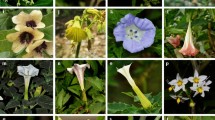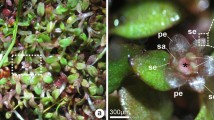Abstract
Phylogenetic studies have greatly impacted upon the circumscription of taxa within the rosid clade, resulting in novel relationships at all systematic levels. In many cases the floral structure of these taxa has never been compared, and in some families, even studies of their floral structure are lacking. Over the past five years we have compared floral structure in both new and novel orders of rosids. Four orders have been investigated including Celastrales, Oxalidales, Cucurbitales and Crossosomatales, and in this paper we attempt to summarize the salient results from these studies. The clades best supported by floral structure are: in Celastrales, the enlarged Celastraceae and the sister relationship between Celastraceae and Parnassiaceae; in Oxalidales, the sister relationship between Oxalidaceae and Connaraceae, and Tremandraceae embedded in Elaeocarpaceae; in Cucurbitales, the sister relationship between Corynocarpaceae plus Coriariaceae, and the grouping of the core Cucurbitales (Cucurbitaceae, Begoniaceae, Tetramelaceae, Datiscaceae); in Crossosomatales, the sister relationship between Ixerbaceae plus Strasburgeriaceae, and between this clade and Geissolomataceae. The core Crossosomatales (Crossosomataceae, Stachyuraceae, Staphyleaceae) and Celastrales as an order are not strongly supported by floral structure. In addition, a new floral feature of potential systematic interest is assessed. Specifically the presence of special cells in flowers with a thickened mucilaginous inner cell wall and a distinct, remaining cytoplasm is surveyed in 88 families and 321 genera (349 species) of basal angiosperms and eudicots. These cells were found to be most common in rosids, particulary fabids (Malpighiales, Oxalidales, Fabales, Rosales, Fagales, Cucurbitales), but were also found in some malvids (Malvales). They are notably absent or rare in asterids (present in campanulids: Aquifoliales, Stemonuraceae) and do not appear to occur in other eudicot clades or in basal angiosperms. Within the flower they are primarily found in the abaxial epidermis of sepals.
Similar content being viewed by others
References
G. M. Anisimova (1983) Begoniaceae M. S. Yakovlev (Eds) Comparative embryology of flowering plants Phytolaccaceae-Thymelaeaceae Nauka Leningrad 144–148
APG (The Angiosperm Phylogeny Group). (2003) An update of the Angiosperm Phylogeny Group classification for the orders and families of flowering plants: APG II. Bot. J. Linn. Soc. 141: 399–436.
M. E. Bakker (1992) Oil and mucilage cells in dicotyledons: ontogeny ultrastructure, distribution and systematic value Doctoral thesis, University of Leiden Netherlands
M. E. Bakker P. Baas (1993) ArticleTitleCell-walls in oil and mucilage cells Acta Bot. Neerl. 42 133–139
Bakker M. E., Gerritsen A. F. (1992a) The development of mucilage cells in Hibiscus schizopetalus. Acta Bot. Neerl. 41: 31–42.
Bakker M. E., Gerritsen A. F. (1992b) Oil and mucilage cells in Annona (Annonaceae) and their systematic significance. Blumea 36: 411–438.
Bakker M. E., Gerritsen A. F. (1992c) Leaf anatomy of Cinnamomum Schaeffer (Lauraceae) with special reference to oil and mucilage cells. Blumea 37: 1–30.
P. Bouchet (1973) ArticleTitleEtude ultrastructurale de la sécrétion du mucilage chez deux espèces de Tiliacées: Tilia vulgaris Hayne et Entelea arborescens R Br. Bull. Bot. Soc. Fr. 120 279–292
C. L. Bredenkamp A. E. Wyk ParticleVan (1999) ArticleTitleStructure of mucilaginous epidermal cell walls in Passerina (Thymelaeaceae) Bot. J. Linn. Soc. 129 223–238 Occurrence Handle10.1006/bojl.1998.0218
K. M. Cameron (2003) ArticleTitleOn the phylogenetic position of the New Caledonian endemic families Paracryphiaceae, Oncothecaceae, and Strasburgeriaceae: a comparison of molecules and morphology Bot. Rev. 68 428–443 Occurrence Handle10.1663/0006-8101(2002)068[0428:OTPPOT]2.0.CO;2
E. J. H. Corner (1976) The seeds of dicotyledons Cambridge University Press Cambridge
A. Cronquist (1981) An integrated system of classification of flowering plants Columbia University Press New York
R. Dahlgren V. S. Rao (1969) ArticleTitleA study of the family Geissolomataceae Bot. Not. 122 207–227
T. J. Davies T. G. Barraclough M. W. Chase P. S. Soltis D. E. Soltis V. Savolainen (2004) ArticleTitleDarwin's abominable mystery: insights from a supertree of the angiosperms Proc. Natl. Acad. Sci. 101 1904–1909 Occurrence Handle14766971 Occurrence Handle1:CAS:528:DC%2BD2cXhs1Sktbo%3D Occurrence Handle10.1073/pnas.0308127100
Endress P. K., Matthews M. L. (2006a) Elaborate petals and staminodes in eudicots: structure, function, evolution. Org. Div. Ecol. (in press).
Endress P. K., Matthews M. L. (2006b) First steps towards a floral structural characterization of the major rosid subclades. Pl. Syst. Evol. 260: 223–251.
P. K. Endress A. Igersheim (1997) ArticleTitleGynoecium diversity and systematics of the Laurales Bot. J. Linn. Soc. 125 93–168 Occurrence Handle10.1006/bojl.1997.0113
P. K. Endress A. Igersheim (1999) ArticleTitleGynoecium diversity and systematics of the basal eudicots Bot. J. Linn. Soc. 130 305–393 Occurrence Handle10.1006/bojl.1999.0255
K. Esau (1977) Anatomy of seed plants EditionNumber2 John Wiley & Sons New York
A. Fahn (1974) Plant anatomy EditionNumber2 Pergamon Press Oxford
A. Fahn (1979) Secretory tissues in plants Academic Press New York
A. Fahn (1988) ArticleTitleSecretory tissues in vascular plants New Phytol. 108 229–257 Occurrence Handle10.1111/j.1469-8137.1988.tb04159.x
M. Gregory P. Baas (1989) ArticleTitleA survey of mucilage cells in vegetative organs of the dictotyledons Israel J. Bot. 38 125–174
H. Huber (1993) ArticleTitle Neurada, eine Gattung der Malvales Sendtnera 1 7–10
A. Igersheim P. K. Endress (1997) ArticleTitleGynoecium diversity and systematics of the Magnoliales and winteroids Bot. J. Linn. Soc. 124 213–271 Occurrence Handle10.1006/bojl.1997.0102
W. S. Judd R. G. Olmstead (2004) ArticleTitleA survey of tricolpate (eudicot) phylogenetic relationships Amer. J. Bot. 91 1627–1644
J. Kårehed (2001) ArticleTitleMultiple origin of the tropical forest tree family Icacinaceae Amer. J. Bot. 88 2259–2274
Lemmens R. H. M. J. (1989) Heterostyly/Pollen morphology. In: Breteler F. J. (ed.) The Connaraceae - a taxonomic study with emphasis on Africa. AUWP 89-6: 56-72/73-75.
Lyshede O. B. (1977) Studies on the mucilage cells in the leaf of Spartocytisus filipes W. B. Planta 133: 255–260.
P. Mariani N. Rascio B. Baldan P. Paiero T. Urso (1988) ArticleTitleEpidermal mucilage cells in leaves of Salix species Flora 181 137–145
M. L. Matthews P. K. Endress (2002) ArticleTitleComparative floral structure and systematics in Oxalidales (Oxalidaceae, Connaraceae, Brunelliaceae, Cephalotaceae, Cunoniaceae, Elaeocarpaceae, Tremandraceae) Bot. J. Linn. Soc. 140 321–381 Occurrence Handle10.1046/j.1095-8339.2002.00105.x
M. L. Matthews P. K. Endress (2004) ArticleTitleComparative floral structure and systematics in Cucurbitales (Corynocarpaceae, Coriariaceae, Tetramelaceae, Datiscaceae, Begoniaceae, Cucurbitaceae, Anisophylleaceae) Bot. J. Linn. Soc. 145 129–185 Occurrence Handle10.1111/j.1095-8339.2003.00281.x
Matthews M. L., Endress P. K. (2005a) Comparative floral structure and systematics in Crossosomatales (Crossosomataceae, Stachyuraceae, Staphyleaceae, Aphloiaceae, Geissolomataceae, Ixerbaceae, Strasburgeriaceae). Bot. J. Linn. Soc. 147: 1–46.
Matthews M. L., Endress P. K. (2005b) Comparative floral structure and systematics in Celastrales (Celastraceae, Parnassiaceae, Lepidobotryaceae). Bot. J. Linn. Soc. 149: 129–194.
M. L. Matthews P. K. Endress J. Schönenberger E. M. Friis (2001) ArticleTitleA comparison of floral structures of Anisophylleaceae and Cunoniaceae and the problem of their systematic relationships Ann. Bot. 88 439–455 Occurrence Handle10.1006/anbo.2001.1494
J. D. Mauseth (1980) ArticleTitleA stereological morphometric study of the ultrastructure of mucilage cells in Opuntia polyacantha (Cactaceae) Bot. Gaz. 141 374–378 Occurrence Handle10.1086/337170
Merino Sutter D., Forster P. I., Endress P. K. (2006) Female flowers and systematic position of Picrodendraceae (Euphorbiaceae s.l., Malpighiales). Pl. Syst. Evol. (in press).
Metcalfe C. R. (1987) Anatomy of the dicotyledons 3 (2nd edn.). Clarendon Press, Oxford.
C. R. Metcalfe L. Chalk (1950) Anatomy of the dicotyledons I, II Clarendon Press Oxford
Metcalfe C. R., Chalk L. (1979) Anatomy of the dicotyledons 1 (2nd edn.). Clarendon Press, Oxford.
Metcalfe C. R., Chalk L. (1983) Anatomy of the dicotyledons 2 (2nd edn.). Clarendon Press, Oxford.
H. H. Mollenhauer (1967) ArticleTitleThe fine structure of mucilage secreting cells of Hibiscus esculentus pods Protoplasma 63 353–362 Occurrence Handle10.1007/BF01252945
Napp-Zinn K. (1973) Anatomie des Blattes. II. Angiospermen A, 1. Handbuch der Pflanzenanatomie, Spezieller Teil VIII 2A. Borntraeger, Berlin.
S. R. S. Rao N. Ramayya (1984) ArticleTitleStructure and taxonomic distribution of epidermal idioblasts in the Malvales Indian J. Bot. 7 117–123
V. Savolainen M. F. Fay D. C. Albach A. Backlund M. Bank Particlevan der K. M. Cameron S. A. Johnson M. D. Lledó J.-C. Pintaud M. Powell M. C. Sheahan D. E. Soltis P. S. Soltis P. Weston W. M. Whitten K. J. Wurdack M. W. Chase (2000) ArticleTitlePhylogeny of the eudicots: a nearly complete familial analysis based on rbcL gene sequences Kew Bull. 55 257–309
J. Schönenberger E. M. Friis M. L. Matthews P. K. Endress (2001) ArticleTitleCunoniaceae in the Cretaceous of Europe: evidence from fossil flowers Ann. Bot. 88 423–437 Occurrence Handle10.1006/anbo.2001.1488
A. E. Schwarzbach R. E. Ricklefs (2000) ArticleTitleSystematic affinities of Rhizophoraceae and Anisophylleaceae, and intergeneric relationships within Rhizophoraceae, based on chloroplast DNA, nuclear ribosomal DNA, and morphology Amer. J. Bot. 87 547–564 Occurrence Handle1:CAS:528:DC%2BD3cXjsVektrY%3D Occurrence Handle10.2307/2656599
F. M. Scott B. G. Bystrom (1970) Mucilaginous idioblasts in okra, Hibiscus esculentus L N. K. B. Robson D. F. Cutler M. Gregory (Eds) New research in plant anatomy Academic Press New York
Simmons M. P., Clevinger C. C., Savolainen V., Archer R. H., Mathews S., Doyle J. J. (2001a) Phylogeny of the Celastraceae inferred from phytochrome B and morphology. Amer. J. Bot. 88: 313–325.
Simmons M. P., Savolainen V., Clevinger C. C., Archer R. H., Davis J. I. (2001b) Phylogeny of the Celastraceae inferred from 26S nrDNA, phytochrome B, atpB, rbcL, and morphology. Molec. Phylogenet. Evol. 19: 353–366.
D. Singh (1955) ArticleTitleEmbryological studies in Cucumis melo var. pubescens Willd J. Ind. Bot. Soc. 34 72–78
Solereder H. (1899/1908) Systematische Anatomie der Dicotyledonen I/II. Enke, Stuttgart.
D. E. Soltis P. S. Soltis M. W. Chase M. E. Mort D. C. Albach M. Zanis V. Savolainen W. H. Hahn S. B. Hoot M. F. Fay M. Axtell S. M. Swensen K. C. Nixon J. S. Farris (2000) ArticleTitleAngiosperm phylogeny inferred from a combined data set of 18S rDNA, rbcL and atpB sequences Bot. J. Linn. Soc. 133 381–461 Occurrence Handle10.1006/bojl.2000.0380
D. E. Soltis P. S. Soltis P. K. Endress M. W. Chase (2005) Phylogeny and evolution of angiosperms Sinauer, Sunderland MA
V. Sosa M. W. Chase (2003) ArticleTitlePhylogenetics of Crossosomataceae based on rbcL sequence data Syst. Bot. 28 96–105
Stevens P. F. (2001 onwards) Angiosperm Phylogeny Website. http://www.mobot.org/MOBOT/research/APweb/.
H. Tobe P. H. Raven (1987) ArticleTitleSystematic embryology of the Anisophylleaceae Ann. Missouri Bot. Gard. 74 1–26 Occurrence Handle10.2307/2399258
S. Trachtenberg A. Fahn (1981) ArticleTitleThe mucilage cells of Opuntia ficus-indica (L.) Mill. - development, ultrastructure, and mucilage secretion Bot. Gaz. 142 206–213 Occurrence Handle1:CAS:528:DyaL3MXkslKqu7Y%3D Occurrence Handle10.1086/337215
B. R. Trognitz M. Hermann (2001) ArticleTitleInheritance of tristyly in Oxalis tuberosa (Oxalidaceae) Heredity 86 564–573 Occurrence Handle11554973 Occurrence Handle1:STN:280:DC%2BD3MrgsFKltQ%3D%3D Occurrence Handle10.1046/j.1365-2540.2001.00870.x
A. Tschirch (1889) Angewandte Pflanzenanatomie. Vol. 1 Urban und Schwarzenberg Wien
G. Volkens (1887) Die Flora der aegyptisch-arabischen Wüste Borntraeger Berlin
S. J. Wagstaff M. I. Dawson (2000) ArticleTitleClassification, origin, and patterns of diversification of Corynocarpus (Corynocarpaceae) inferred from DNA sequences Syst. Bot. 25 134–149 Occurrence Handle10.2307/2666679
H. Walliczek (1893) ArticleTitleStudien über die Membranschleime vegetativer Organe Jahrb. Wiss. Bot. 25 209–277
W. C. West (1969) ArticleTitleOntogeny of oil cells in the woody Ranales. Bull. Torrey Bot. Club 96 329–344 Occurrence Handle10.2307/2483738
Zhang L.-B., Renner S. S. (2003) Phylogeny of Cucurbitales inferred from seven chloroplast and mitochondrial loci. Botany 2003 Abstract.
L.-B. Zhang M. P. Simmons (2006) ArticleTitlePhylogeny and delimitation of the Celastrales inferred from nuclear and plastid genes Syst. Bot. 31 122–137 Occurrence Handle10.1600/036364406775971778
L.-B. Zhang M. P. Simmons A. Kocyan S. S. Renner (2006) ArticleTitlePhylogeny of the Cucurbitales based on DNA sequences of nine loci from three genomes: implications for morphological and sexual system evolution Molec. Phylogenet. Evol. 39 305–322 Occurrence Handle16293423 Occurrence Handle1:CAS:528:DC%2BD28XkvF2ms7c%3D Occurrence Handle10.1016/j.ympev.2005.10.002
Author information
Authors and Affiliations
Corresponding author
Rights and permissions
About this article
Cite this article
Matthews, M.L., Endress, P.K. Floral structure and systematics in four orders of rosids, including a broad survey of floral mucilage cells. Plant Syst. Evol. 260, 199–221 (2006). https://doi.org/10.1007/s00606-006-0443-8
Received:
Accepted:
Published:
Issue Date:
DOI: https://doi.org/10.1007/s00606-006-0443-8




